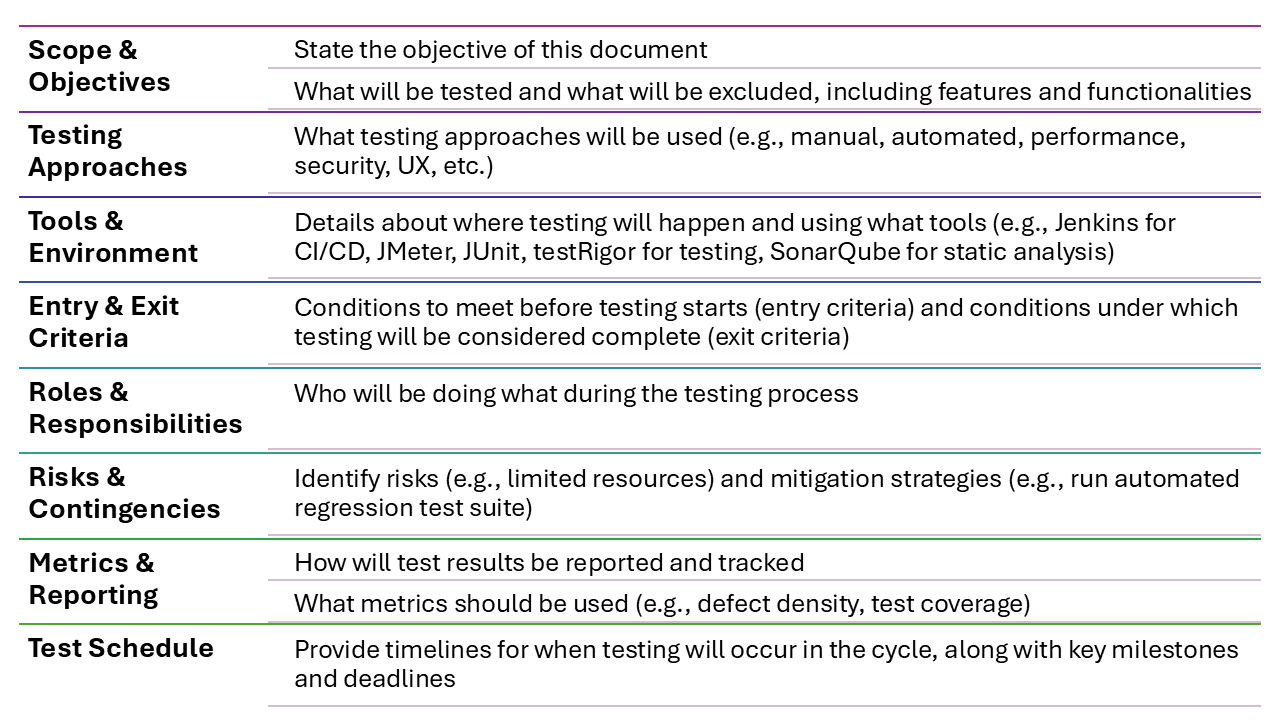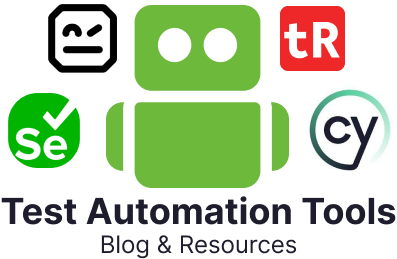Delivering reliable apps swiftly is vital in the rapidly evolving software development strategies adopted today. Having a good suite of test cases isn’t enough. Teams need a systematic guide to help them use these test cases for validation. A test strategy document becomes critical at this point.
A clearly defined test strategy is the foundation for how testing should be implemented across projects. It ensures uniformity, improves quality assurance results, and coordinates testing operations with wider technical and business goals.
This article tries to explain the definition of a test strategy, its importance, how it stands out from a test plan, the different types of strategies, and how to create a test strategy that complements the goals of your organization.
What is Test Strategy in Software Testing?
A high-level plan that defines the methodology, scope, techniques, and goals for software testing across one or more projects is referred to as a test strategy. Unlike tactical documents, a test strategy integrates testing with risk priorities and organizational standards. This is quite clear in the test strategy definition found across the internet: “What method must be used, which modules must be analyzed, what standards apply for entry and exit, what type of testing is required?”
A test strategy operates at the organizational level and is not project-specific; it defines how you validate, instead of the specific what and when, which is where the test plan comes in.
Test Strategy vs. Test Plan
While the terms “test strategy” and “test plan” are often used in tandem, they refer to two unique but complementary documents. Efficient quality assurance needs an understanding of the difference.
| Aspect | Test Strategy | Test Plan |
|---|---|---|
| Scope | Organization-wide or across different projects | Specific to one project or release |
| Purpose | Defines how testing will be conducted | Defines what will be tested, when, and by whom |
| Level | Strategic, high-level | Tactical, detailed |
| Stability | Usually static; updated periodically | Dynamic; updated every project lifecycle |
| Contents | Approach, tools, test types, entry/exit criteria | Test cases, schedules, test environment needs, resources |
| Audience | QA leadership, stakeholders, developers | QA engineers, project managers, developers |
Key Takeaway:
The test plan is your execution roadmap for a specific project or product, and the test strategy is your general policy and method for testing.
When put together, they cut down on effort replication, provide clarity, and ensure consistent quality throughout releases.
Necessary Elements of a Test Strategy Document
Experts in the testing industry believe and highlight that a test strategy needs to consist of:
- Testing Approach and Methodology: Clearly define which component is being tested and why.
- Scope and Goals: Levels (unit, integration), and specific methods (manual, automated).
- Test Environment and Tools: Specify platforms, frameworks, and infrastructure.
- Entry and Exit Criteria: Define quality gates for test stages.
- Roles and Responsibilities: Clearly establish the composition of the QA team.
- Risks and Mitigation: Recognize potential hurdles and backup plans.
- Metrics and Reporting: Set up KPIs such as pass rates and defect density.
- Timeline and Schedule: Define dependencies and phases.

These elements provide your test strategy document with a comprehensive overview that will guide the QA process from the beginning to the end.
Types of Test Strategies in Software Testing
Every test strategy is unique. Below is a list of models that you can customize to fit your needs and environment.
Analytical Strategy
- The focus here is on the amount of risk associated with different features and areas of the application. Ideal for most projects, especially those with limited resources or tight deadlines.
Model-based Strategy
- Such strategies are modeled after the system’s behavior. The idea is to leverage system models to gain the most test automation and coverage. Good for complex systems, embedded systems, or projects where formal modeling is already used.
Methodical Strategy
- It uses pre-defined standards, such as compliance standards or checklists. This makes it suitable for projects requiring high levels of compliance, specific industry regulations, or basic, repeatable checks.
Reactive Strategy
- It emphasizes bug-driven validation, which seeks to address issues as soon as they appear. It’s often associated with exploratory testing, where discoveries during testing guide subsequent tests. It’s about finding defects as you go. Suitable for Agile environments, late-stage testing, or when requirements are vague or rapidly changing. It’s often combined with other strategies.
Consultative Approach
- It relies heavily on external expertise, such as consultants, domain experts, or even customer feedback, to guide testing efforts and identify key areas of concern. Suitable for projects in niche domains, or when internal expertise is limited.
Regression-Averse Strategy
- It prioritizes automation to detect bugs early and consistently. Good for all projects, but especially critical for mature products with a large existing codebase.
Selecting the right strategy helps simplify your approach based on project dynamics and risk profiles.
A Step-by-Step Guide on Writing a Test Strategy Document
Stakeholder alignment and iterative planning are necessary to build a strong test strategy document. Here’s how to go about the process:
Define the Goals and Scope
- Clearly specify which features, systems, and quality attributes you wish to test. For example, “Test user login and payment functionality across different web and mobile platforms.”
Choose your Method of Testing
- Make the decision between performance/security testing, automation pipelines (integration, unit), and manual testing.
Determine the Conditions for Entry and Exit
- Establish clear acceptance criteria such as “All critical defects solved, >90% automation pass rate.”
Align Testing Environments and Tools
- Leveraging testing tools like AWS Test Environments, testRigor, JMeter, or Selenium should be documented in detail.
Assign Resources and Roles
- Establish ownership and roles clearly. This designation will help everyone work simultaneously without any confusion.
Determine the Risks and Countermeasures
- Strategize backups and discuss potential issues such as restricted schedules or legacy system limitations.
Explain Metrics and Reporting
- Establish reporting standards such as defect rejection rates, cycle time, and test coverage.
Furnish the History of Approval and Revision
- Monitor document updates and versions to ensure continuous improvement and QA governance.
Integrating Test Strategy into the Entire QA Process
Your test strategy must operate in unison with test planning and the Software Testing Life Cycle (STLC). Here’s how it fits into the STLC:
- Requirement analysis: Leverage requirement analysis to direct strategy as per the business requirements.
- Creating Test Strategy: Develop a test strategy by defining the guidelines and resources.
- Test Planning: Build project-specific test plans using a predefined structure.
- Test Design and Execution: Build test cases and execute them.
- Test Reporting and Closure: Present findings and analyze performance in relation to the plan.
Your framework should support effective and scalable delivery due to the seamless flow described above.
Test Strategy Best Practices
These efficient practices are endorsed by experts in the testing industry:
Align with Business Objectives
- Make sure that stakeholder values and not just technical issues are reflected in QA priorities.
Frequently Evaluate and Modify
- With each important release or advancement in technology, review your strategy. This helps stay relevant.
Set Risk Priorities
- Always prioritize work on critical, high-impact modules.
Balances both Manual and Automated Testing
- Automate repetitive, stable test cases and save manual testing for user experience assessments and exploration.
Maintain Visibility
- Use dashboards and status reports to clearly communicate risks, metrics, and strategy.
Test Strategy Example
Below is a condensed outline that you can change to meet your needs:
Introduction
Scope and Objectives
Testing Approach
Tools and Environments
Entry/Exit Criteria
Roles and Responsibilities
Risks and Contingencies
Metrics and Reporting
Review Cycle
|
The Criticality of a Well-Defined Test Strategy
A robust test strategy leads to many advantages:
- Greater Efficiency: Reduces repetitive planning overhead.
- Risk Mitigation: Predicts quality issues before they become showstoppers.
- Scalability: Supports multiple releases and complicated deployments.
- Transparency: Provides visibility and confidence to stakeholders.
- Consistency across projects: QA teams need to comply with standardized practices.
Tips for Consistent Improvement of Test Strategy
The goal is to evolve a strategy rather than only to create it:
- Tooling Enhancements: Include infrastructure modifications such as CI/CD and cloud validation.
- Feedback loops: Validate test results and adjust entry/exit criteria.
- Team Learning: Include retrospectives and post-mortems.
The strategy remains updated, efficient, and in line with evolving business needs when it is regularly fine-tuned.
Conclusion
Rather than just a definition, a convincing response to the query, “What is test strategy?” is an organized method that transforms quality assurance from a checklist-driven task to a competitive edge. Your test strategy will enable dependable, high-quality software deliveries if you define methodologies, tools, risks, scope, and metrics, and revise in response to feedback.
